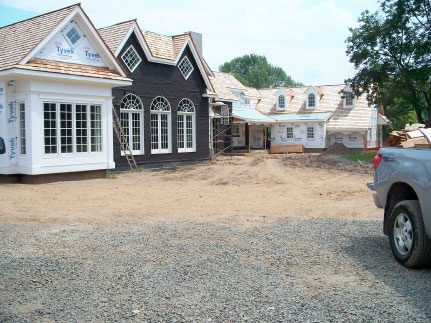
Warm Earth
It’s cold outside. For many homeowners, cold weather equals high utility bills (and if your home isn’t well insulated, it also means a lot of the heated air you pay for slips through the cracks).
The good news is warmer temperatures are underfoot—literally. Approximately ten or so feet beneath the ground’s surface, 50-degree temperatures are constant year-round. At the soon-to-be complete, LEED-certified Sheeleigh home a geothermal heating and cooling unit—Comfortaire GeoMax2 by Heat Controller—will tap into the earth’s warm interior and translate this “free” energy into heat.
At Sycamore Farms, six vertical wells were dug about twenty yards from the house. The wells hold water with a small amount of ethanol (to keep the water from freezing) and use about 300 feet of tubing that connects to the house. The fluid passes through the tubes, is then processed through a heat pump, and ultimately distributed as warm air through the home’s ductwork system.
“The heat pump works similar to the way a refrigerator works,” says Antonio Poccia, general manager of Perfection Contracting, Inc. Heating and Air Conditioning in Newton, which installed the unit. “But in this case, it moves cold inside air out and moves warmer exterior air in.” During the summer months, when the outdoor temperature is elevated, the pump basically works in reverse, repurposing the cooler underground temps to produce cool air.
The initial financial output (for well installation, etc) is greater for geothermal systems compared to using conventional heating and cooling sources. However, the upside is that geothermal heating and cooling is environmentally friendly, and energy efficient offering substantially lower operating expenses over the long term—up to a 70 percent reduction in utility bills is estimated. In addition, the system is 100-percent silent, Poccia says, and nearly maintenance free.
How’s the Air?
Along with keeping the interior air temperate, Perfect Contracting also installed an Energy Recovery Ventilation system that will keep fresh air circulating at the Sheeleighs. One of the signature features of a LEED home is superior insulation, but keeping the elements out can mean keeping fresh air out, too. To combat that ERVs offer improved air quality by moving the indoor air out and bringing fresh air in continuously. “It’s virtually moving the entire volume of air in your house out three times a day over a 24-hour period,” Matt Sheeleigh explains. “There is clean air all the time.”
Although the risk of off gassing (the releasing of potential harmful chemicals into the air) is lower in LEED homes because they typically use fewer products that contain harmful chemicals, EVRs also kill viruses like influenza and have been proven to lower instances of asthma and related conditions, keeping families healthier.
